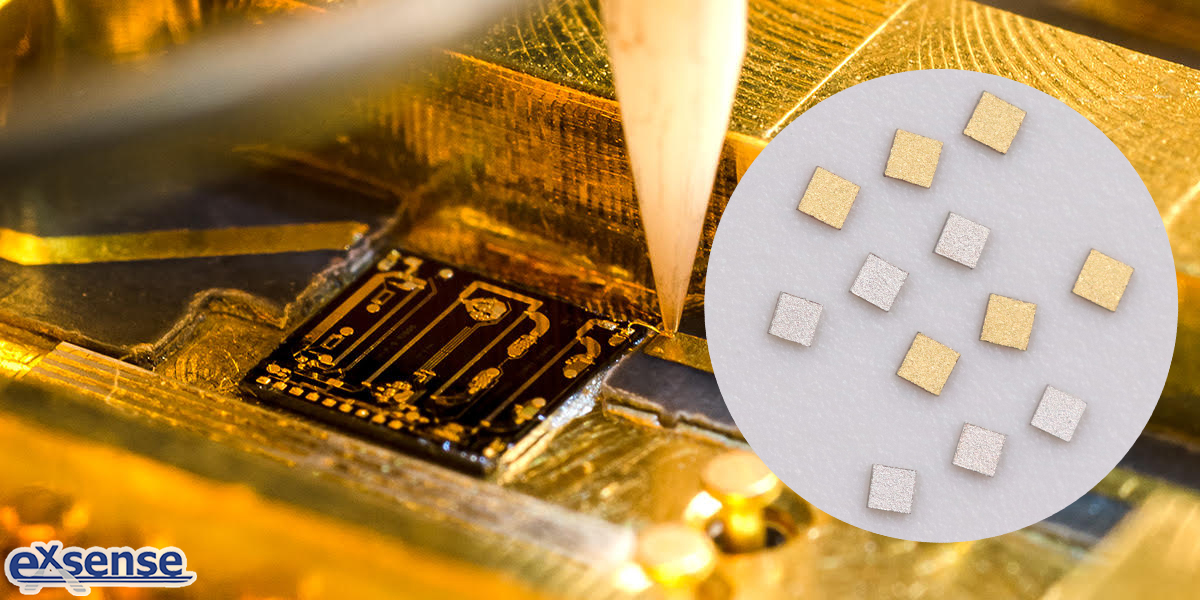
NTC thermistor chip produced by EXSENSE Electronics Technology Co., Ltd., with characteristics of high accuracy (accuracy can up to ±0.5%, ±1%, ±2%, ±3%), rapid response, small size (minimum size can be 0.3*0.3mm), etc., which are widely used in infrared thermopile, IGBT module, semiconductor module, integrated module, etc. In the module encapsulating, the wire bonding is an important part, it's through ultrasonic bonding, thermocompression bonding and other ways to form a connection between the wire and NTC thermistor chip.
In general, gold is used as the main wire material for the bonding of integrated circuits. However, copper wire bonding has replaced the gold wire bonding in the main market (in 2017, the market share of copper wire bonding has reached 22%) at present, the market share of silver wire bonding is also increasing (in 2017, the market share of silver wire bonding has reached 11%), and this change is still continuing.
1. copper wire bonding
Since 2008, copper wire bonding has gradually developed, showing the trend of replacing the gold wire bonding. More and more semiconductor factories have successfully used copper wire in most integrated circuits instead of gold wire for the bonding of thermistor chips. The process requirements of copper wire bonding are much more stringent than gold wire bonding, which includes unbonded copper wire storage, protective atmosphere control when bonding, shape of copper ball formation, and Intermetallic Compound (IMC) generation, etc. Although the cost of copper wire is about 20% of the cost of gold wire, the additional cost of its process is higher. For example, copper wire is not easy to form intermetallic compounds, the thickness of aluminum bonding pad should be at least 0.8 μm, the bonding pressure is 30% greater than the gold wire, which is easy to lead to the bonding pad shedding, the formation of craters or dielectric breakdown, etc. In order to solve the above problems and improve the reliability of copper wire bonding, most factories will take the method of adding through hole to improve the structure of bonding pad and adopting higher ultrasonic frequency.
In the high temperature storage test, the growth rate of intermetallic compound of copper-aluminum bonding is slower than that of gold-aluminum bonding, which indicates that the copper-aluminum bonding changes slowly and its bonding strength is not easy to change. At high temperatures, the intermetallic compound of gold-aluminum bonding grows fast, and always accompanied by the production of the Kirkendall Effect, resulting in a decrease in bonding strength. From this point of view alone, the reliability of copper wire bonding is higher. However, in high-humidity storage tests,the intermetallic compound of copper-aluminum bonding are susceptible to chemical or electrochemical corrosion by halogens (e.g. Cl, Br) in plastic sealant, which can transform copper-aluminum intermetallic compounds into copper, aluminum oxides.
2. silver wire bonding
The silver-based aluminum wire bonding has been invented as early as 1970, and it mainly uses wedge-shape welding for the bonding of NTC thermal chips, that is, the main bonding method of the second welding spot. But silver wire bonding in aluminum metalization is more than a decade ago, its market share grew from scratch to occupy about 11% of the share in 2017, second only to gold wire, copper wire bonding. Around 2012, silver wire bonding was used not only in dynamic random access memory (DRAM) packages, thin small outline packages (TSOP), but also in digital circuits logic(DLC). On one hand, the cost of silver wire is lower than that of gold wire; On the other hand, the process window of silver wire is wider than the copper wire, and it can do reverse bonding, which makes the silver wire bonding be widely used in thin bonding pads, easy-to-crack bonding pad, and bonding-pad-to-bonding-pad connection.
However, in the range of short wave, silver wire has a high reflectivity and poor mechanical property, and the more important reliability problem is the corrosion of the silver-aluminum contact position. There are several main components of silver wire material, including pure silver and alloys (silver content is less than 90%) containing palladium or gold, the mainstream silver wire bonding contains 88% Ag, the remaining is Pd and Au; Alloys are used because the diffusion rates of silver and aluminum differ greatly, and Pd can slow the growth rate of intermetallic compounds.At present, in order to further reduce costs, 95% Ag alloy silver wire also began to use, which makes the cost of silver wire is lower (up to 5%) than copper wire.
There are two ways to evaluate silver wire bonding - high temperature storage test (HTS, the temperatures generally exceeds 150℃) and humidity storage tests. In addition to the commonly used 85℃/85% RH, a variety of highly accelerated stress test, Pressure Cooker Test and other evaluation methods are also adopted.
The high temperature storage test used the high temperature aging condition of 150℃/1000h or 200℃/250h, and by testing different silver wire (silver purity of 88% to 99%), the temperature range of 150℃ to 200℃ is not enough to cause significant degradation of the silver-aluminum bonding, its electrical properties were good and the phase position of intermetallic compound did not change significantly, and there was no obvious performance of the Kirkendall Effect, which are better than the gold wire bonding.
3. the comparison of different bonding wire materials
In gold wire, silver wire, copper wire, gold is the softest, so the bonding force is the smallest, which is not easy to damage the bonding pad; Copper wire is the hardest, therefore, the bonding process of copper wire needs to optimize parameters to ensure that the intermetallic compound can be formed without damaging the bonding pad; The hardness of the silver wire is fall in between.
In fact, in the whole bonding system, the largest impedance is the intermetallic compound, not the wire itself. Intermetallic compounds (Cu9Al4, Cu3Al2) of copper wire bonding, its resistance rate is 13~15 (10~8Ω·m), intermetallic compounds (Ag3Al, Ag2Al) of silver wire, its resistance is10 (10~8Ω·m), in a comprehensive view, impedance of silver wire bonding is only 10%~20% higher than copper wire bonding.
The high-precision NTC thermistor chip developed and produced by EXSENSE Electronics Technology Co., Ltd., which is suitable for bonding and can be customized according to customer requirements.



